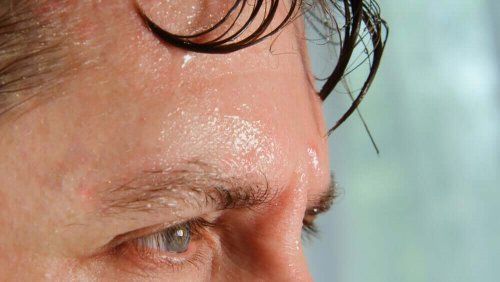Discover Six Effects of Heat on the Body


Written and verified by the doctor Leonardo Biolatto
The effects of heat on the body manifest when the system that regulates body temperature begins to fail. If this system doesn’t regulate itself, heat can lead to life-threatening situations.
Human beings have a bodily system that’s prepared to maintain the temperature at approximately 98°F. This body temperature allows the organs to function normally. When bodily temperature changes, undesirable effects appear. When it undergoes huge changes, it manifests with pathological symptoms. Both hypothermia and hyperthermia can cause death.
How the body controls the effects of heat
The body has two mechanisms to dissipate heat:
- Increased blood flow to the skin. By causing vasodilation in the skin, the body produces heat exchange with the environment. This allows excess heat to escape so it doesn’t affect the organs.
- Sweating. It removes excess heat by evaporation. When sweat evaporates, it cools the body. The human body is equipped with sweat glands that can eliminate up to half a liter of sweat per hour.
When the environment is too hot, with a temperature of over 95°F, sweating can reach a limit. If the body detects that the loss of fluid and salts through sweat can lead to dehydration, it suspends sweating. At that point, it’s possible for the effects of heat that we’ll detail below to manifest in the body.

Sweating is one of the body’s defense mechanism to heat.
You should also read: 5 Things Your Sweat Says about Your Health
The effects of heat on the body
Bad breath
Dehydration affects all bodily tissues. One of the affected tissues is oral mucosa. Dehydrated oral mucosa causes dry mouth due to a lack of saliva. Without saliva, bacteria proliferate, as one of the defense mechanisms is exhausted. The proliferation of bacteria causes bad breath or halitosis.
Heat cramps
Sweating not only removes liquid from the body but also salts and electrolytes. The human body needs electrolytes for cell functions. One of the tissues that require the most salts is muscle tissue.
Therefore, if you’re sweating too much and lose a lot of electrolytes, you can suffer from muscle cramps or spasms in your extremities. This is a warning sign. If you have heat cramps, you should stop physical activity and hydrate. The next step, if it isn’t prevented, is exhaustion.
Heat exhaustion
When necessary precautionary measures aren’t taken, the loss of fluids and salts through sweating can lead to bodily exhaustion, especially in situations of physical effort.
Overall, the symptoms of heat exhaustion include:
- Tachycardia
- Generalized fatigue
- Irritability
- Hyperventilation
- Hypotension
Heat illness
This clinical situation is similar to heat exhaustion. However, the difference is that heat illness is caused by prolonged exposure to the sun. A person suffers from heat illness when their regulatory mechanisms failed due to this prolonged sun exposure.
The symptoms of heat illness are:
- Headache
- Fatigue
- Facial congestion
- Nausea and vomiting
- Thirst

Prolonged sun exposure causes heat illness.
This article may interest you: The Best Tips to Protect Your Hair From the Sun
Heat syncope
Heat syncope has several causes. One of them is the effect of heat on the body. Extreme heat causes excessive vasodilation and redistribution of blood, which decreases blood flow to the brain.
Heat syncope is a clinical condition caused by the inability of blood flow to maintain proper irrigation of the brain. Since not enough blood reaches the brain, it also doesn’t get enough oxygen and the central nervous system activates a control mechanism.
The adjustment mechanism is to try to make sure the body is in a horizontal position to improve blood flow to the brain. Therefore, the symptom of heat syncope is fainting. In general, it’s preceded by blurred vision and wobbling. Fortunately, recovery is fast. When the body is in a horizontal position, enough blood reaches the brain.
Heatstroke
The most severe form of the harmful effects of heat on the body is heatstroke. This can cause death and is considered a medical emergency.
The first symptoms are those of heat exhaustion or heat illness. When these situations aren’t resolved in the short term, they progress towards heatstroke.
Up to a body temperature of 104°F, the body is able to activate some defense mechanisms. If the temperature exceeds 105°F, these mechanisms stop working. The cells are unable to work under these conditions and this can lead to multiorgan failure.
How to prevent the effects of heat on the body
To prevent the harmful effects of heat on the body, you can take some basic measures. Following them can prevent a dangerous outcome. Prevention consists of:
- Good daily hydration.
- Not exposing yourself to the sun without protection for prolonged periods.
- Suspending work and exercise activities if or when you develop symptoms of heat cramps or heat exhaustion.
All cited sources were thoroughly reviewed by our team to ensure their quality, reliability, currency, and validity. The bibliography of this article was considered reliable and of academic or scientific accuracy.
- Moreno, María del Mar Sánchez, Rosa Isabel Cristóbal Martínez, and Raquel Sola Díaz. “Manifestaciones del golpe de calor en personas mayores.” Calidad de vida, cuidadores e intervención para la mejora de la salud. Asociación Universitaria de Educación y Psicología (ASUNIVEP), 2017.
- Arredondo-García, J. L., et al. “Agua: la importancia de una ingesta adecuada en pediatría.” Acta pediátrica de México 38.2 (2017): 116-124.
- Bustamante Cabrera, Gladys, and Guisela Margoth Magne Quispe. “Deshidratación.” Revista de Actualización Clínica Investiga 36 (2013): 1857.
This text is provided for informational purposes only and does not replace consultation with a professional. If in doubt, consult your specialist.








